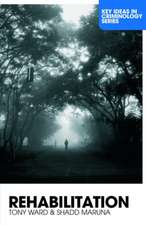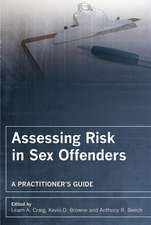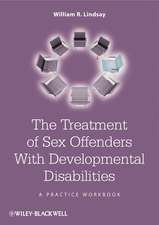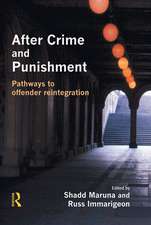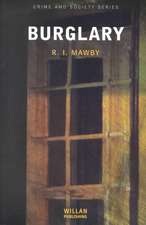Criminal Profiling: International Theory, Research, and Practice
Editat de Richard N. Kocsisen Limba Engleză Hardback – 6 iul 2007
| Toate formatele și edițiile | Preț | Express |
|---|---|---|
| Paperback (2) | 787.58 lei 6-8 săpt. | |
| Humana Press Inc. – 5 noi 2010 | 787.58 lei 6-8 săpt. | |
| Humana Press Inc. – 5 noi 2010 | 842.74 lei 6-8 săpt. | |
| Hardback (2) | 731.43 lei 6-8 săpt. | |
| Humana Press Inc. – 6 iul 2007 | 731.43 lei 6-8 săpt. | |
| Humana Press Inc. – 29 mai 2006 | 1165.64 lei 6-8 săpt. |
Preț: 731.43 lei
Preț vechi: 769.92 lei
-5% Nou
Puncte Express: 1097
Preț estimativ în valută:
139.95€ • 146.91$ • 116.17£
139.95€ • 146.91$ • 116.17£
Carte tipărită la comandă
Livrare economică 11-25 aprilie
Preluare comenzi: 021 569.72.76
Specificații
ISBN-13: 9781588296849
ISBN-10: 1588296849
Pagini: 436
Ilustrații: XXII, 418 p. 10 illus.
Dimensiuni: 152 x 229 x 34 mm
Greutate: 0.81 kg
Ediția:2007
Editura: Humana Press Inc.
Colecția Humana
Locul publicării:Totowa, NJ, United States
ISBN-10: 1588296849
Pagini: 436
Ilustrații: XXII, 418 p. 10 illus.
Dimensiuni: 152 x 229 x 34 mm
Greutate: 0.81 kg
Ediția:2007
Editura: Humana Press Inc.
Colecția Humana
Locul publicării:Totowa, NJ, United States
Public țintă
Professional/practitionerCuprins
Profiling Crimes of Violence.- Homicidal Syndromes.- Offender Profiles and Crime Scene Patterns in Belgian Sexual Murders.- Profiling Sexual Fantasy.- Murder by Manual and Ligature Strangulation.- Criminal Propensity and Criminal Opportunity.- New Techniques and Applications.- Case Linkage.- Predicting Offender Profiles From Offense and Victim Characteristics.- Criminal Profiling in a Terrorism Context.- Geographic Profiling of Terrorist Attacks.- Legal and Policy Considerations for Criminal Profiling.- Criminal Profiling as Expert Evidence?.- Criminal Profiling.- The Phenomenon of Serial Murder and the Judicial Admission of Criminal Profiling in Italy.- Criminal Profiling and Public Policy.- The Observations of the French Judiciary.- The Image of Profiling.- Critiques and Conceptual Dimensions to Criminal Profiling.- Contemporary Problems in Criminal Profiling*.- Fine-Tuning Geographical Profiling.- Skills and Accuracy in Criminal Profiling*.- Investigative Experience and Profile Accuracy.- Schools of Thought Related to Criminal Profiling.
Recenzii
From the reviews:
"Criminal Profiling: International Theory, Research and Practice, is a compilation of scholarly works by some 30 contributors from around the globe. … The book contains a mix of both interesting and insightful chapters … . this book may be of interest to those looking for international grounding or to academics looking for avenues for future research. Richard Kocsis should be commended on his continued efforts to lend scientific rigour to a field that is often a difficult research subject." (Melissa Martineau, Canadian Society of Forensic Science, May, 2008)
"Richard Kocsis presents us with a balanced, thoughtful, and insightful collection of papers dealing with the state of the art in criminal profiling at this point in time, along with suggestions about where future research needs to go. … In summary, this is a very intriguing and thoughtful book that has some excellent and very thought-provoking chapters. … this book is an excellent contribution to what is often a very misrepresented field." (David L. Shapiro, PsycCRITIQUES, Vol. 53 (15), 2008)
"This book describes criminal profiling from the perspective of authors from many different countries. … The book is intended as a reference for forensic scientists, consultant forensic psychologists, and students. … deals with a broad spectrum of issues in the field of criminal profiling from an international perspective. It is full of research that links theory to practice. … is really for serious students of criminology. … enhanced by the contributions of authors from many different countries, providing cross-cultural comparisons." (Gary B Kaniuk, Doody’s Review Service, November, 2007)
"Criminal Profiling: International Theory, Research and Practice, is a compilation of scholarly works by some 30 contributors from around the globe. … The book contains a mix of both interesting and insightful chapters … . this book may be of interest to those looking for international grounding or to academics looking for avenues for future research. Richard Kocsis should be commended on his continued efforts to lend scientific rigour to a field that is often a difficult research subject." (Melissa Martineau, Canadian Society of Forensic Science, May, 2008)
"Richard Kocsis presents us with a balanced, thoughtful, and insightful collection of papers dealing with the state of the art in criminal profiling at this point in time, along with suggestions about where future research needs to go. … In summary, this is a very intriguing and thoughtful book that has some excellent and very thought-provoking chapters. … this book is an excellent contribution to what is often a very misrepresented field." (David L. Shapiro, PsycCRITIQUES, Vol. 53 (15), 2008)
"This book describes criminal profiling from the perspective of authors from many different countries. … The book is intended as a reference for forensic scientists, consultant forensic psychologists, and students. … deals with a broad spectrum of issues in the field of criminal profiling from an international perspective. It is full of research that links theory to practice. … is really for serious students of criminology. … enhanced by the contributions of authors from many different countries, providing cross-cultural comparisons." (Gary B Kaniuk, Doody’s Review Service, November, 2007)
Textul de pe ultima copertă
The technique commonly referred to as ‘criminal profiling’ is one in which crime behaviours are evaluated to predict the likely attributes of an offender. In practice, the technique has enjoyed steady growth and interest over the past three decades. The present volume draws together research from scholars and practitioners from across the globe that examines from a range of multidisciplinary perspectives the use, application and value of this form of profiling.
The material canvassed throughout this text not only examines research and theoretical principles for the assessment of crimes, but extends to exploring the range of issues facing the theoretical development of criminal profiling and its practical, legal and professional practice. Topics include the examination of homicidal syndromes, the association of crime scene behavior patterns with offender characteristics, criminal propensity and opportunity, the identification of crimes committed by the same offender, the legal admissibility of profiling, its accuracy, and the problems confronting the contemporary practice of criminal profiling. This volume is likely to become an essential reference for forensic practitioners and students alike operating in the fields of criminology, law and policing and anyone with a genuine interest in the investigation and resolution of violent crime.
The material canvassed throughout this text not only examines research and theoretical principles for the assessment of crimes, but extends to exploring the range of issues facing the theoretical development of criminal profiling and its practical, legal and professional practice. Topics include the examination of homicidal syndromes, the association of crime scene behavior patterns with offender characteristics, criminal propensity and opportunity, the identification of crimes committed by the same offender, the legal admissibility of profiling, its accuracy, and the problems confronting the contemporary practice of criminal profiling. This volume is likely to become an essential reference for forensic practitioners and students alike operating in the fields of criminology, law and policing and anyone with a genuine interest in the investigation and resolution of violent crime.
Caracteristici
Combines vast empirical research with the author's personal experiences Draws together for the time the characteristics of the CAP approach to profiling violent crimes Describes for the experienced and lay person how to use the various CAP models to profile a particular crime without necessarily needing to comprehend how each model was originally built

